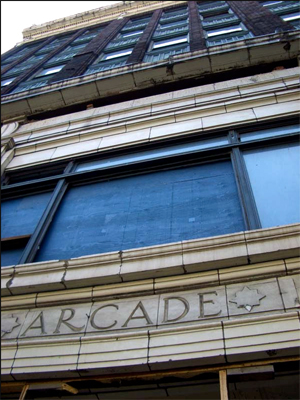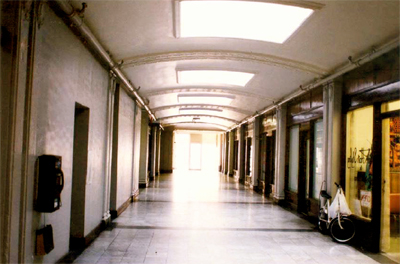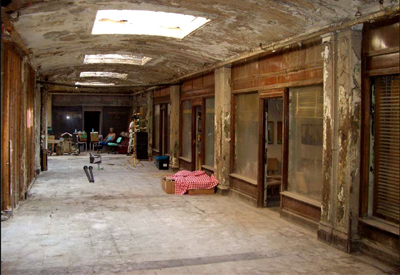How were people convinced to change from hating the condition of the building to hating the building itself?
By Graham Crawford
Published October 20, 2006
(This article is also being published in the Durander, the newsletter of the Durand Neighbourhood Association.)
If you're a Hamiltonian of a certain vintage, it's likely you have fond memories of the Lister Block. For more than 50 years, the Lister was a destination building - whether to get your hair cut, or to check out the sheet music at Ann Foster's, or to visit your dentist or your lawyer.

The Lister Block
Over the last 20 years, the Lister has declined significantly. First, it was emptied of its tenants; a process that took a few years. Then, promised re-development came and went as frequently as did the owners. But through it all, many people remained fans of the Lister. Some of us loved the building. All of us hated its condition.
For years now, the Lister has stood both as a stubborn reminder of the vibrancy and vision that was the Hamilton of our youth; and as a symbol of the challenges faced by our downtown core.
The Lister, however, is not the only building in the core where property standards have not been maintained. The Thistle Club building and site and the Club Hypnotique are two others of dishonourable mention within the Durand neighbourhood.
Architecturally, perhaps the Lister is not so much elegant as it is substantial. In fact, it is its solidity that's likely to save this great icon of Hamilton's belief in itself.

The Lister Block retail mall when it was still open to the public.

What it looks like today.
While there are many questions surrounding the as yet incomplete Lister story, one that confounds is, "How were people convinced to change from hating the condition of the building to hating the building itself?" It's as if the Lister Block itself had become the problem, with nary a mention of the owners, both present and past, and their responsibility to maintain their property, just like the rest of us.
But, through the valiant, and sometimes scorned, actions of Councillors Bob Bratina and Brian McHattie, and through the measured involvement and guidance of the Ontario Minister of Culture, Caroline Di Cocco, the Lister may once again become a contributing citizen of the City of Hamilton.
While there are many details that are still to be worked out, here are some relevant facts:
Rather than demolish and replicate, the recommended path forward is to "rehabilitate" the Lister.
The Hamilton Public Health Unit will lease 60,000 sq. ft., or 100 percent of the rehabilitated Lister, minus approximately 2500 sq. ft. of retail space along King William and James.
The Ministry of Health will pay 75 percent of the lease costs as part of its normal funding of local health care units. The City is asking the Ministry to cover the relocation costs of moving the unit from its current location in the Right House.
The developer has requested that the City (and implicitly the Ministry of Health) sign a 20-year lease rather than the original 15-year lease citing increased financing charges.
The developer has plans for a Phase 2 which involves the two adjacent buildings on either side of the Lister; as well as a new tower in the rear of the complex.
Finally, with all due respect to all of the parties who have worked so hard to come this far, here are some relevant questions:
Why did the City of Hamilton not enforce its own property standards regulations on the Lister Block? Generally speaking, buildings don't turn into eyesores overnight, and the Lister is no exception.
Why does the developer require a 20-year lease instead of the original 15? Surely getting necessary financing would be facilitated by having 100 percent of your 'rehabilitated' building leased for 15 years to two levels of government. Perhaps trying to get two levels of government to cover all of your costs for 'rehabilitation' is a bit much to ask.
Why did it take the appointment of a provincial mediator to generate the brain wave that we could locate the Public Health Department in the building, thereby ensuring that the provincial government would cover 75 percent of the rent? While creativity indeed can strike at the oddest of times, this seems to be a fairly obvious 'breakthrough'.
Why do the reports of the Lister's structural condition seem to be the opposite to what was presented to City Council only a few months ago? Obviously, the building's condition didn't improve through an intervention by the owner, yet the reports from the provincial mediator say categorically that structurally the building is solid as a rock.
Just asking.
By Lister lover (anonymous) | Posted October 20, 2006 at 10:45:57
What will happen to the Right House? The Right House won't be able to suffer the loss of its largest tenant, its arcade/mall is already vacant except for the Tim Hortons, which by the way is far too busy. Folks try getting your coffee at Pam's next block over in Jackson or Infusions across Gore.
Great article, nice to see photos of the Lister mall that don't show the decay. I wish I could've experienced the building back then.
It is indeed strange that a structural report is a complete opposite of the Liuna/Hi-Rise report from a few months prior. It demonstrates what they really want to do.
This deal stinks. Its time for the city to get serious about property standards enforcement as well as new building standards with an Architectural Review Board. Windowless, stucco shitboxes like the new motel on Market street would've never been approved.
By Steeltown (registered) | Posted October 20, 2006 at 11:00:50
I believe the Planning and Economic department was supposed to move into the Lister Block and some Public Health offices. So I'm assuming Planning and Economic department will instead move into the Right House once the Public Health department moves into the Lister.
You must be logged in to comment.
There are no upcoming events right now.
Why not post one?